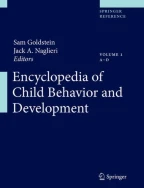
The preoperational period refers to the second stage (2–7 years) in Jean Piaget’s theory of cognitive development which spans toddlerhood, preschool and early school ages. This stage is characterized by the child’s beginning to use symbols, understanding tasks of conservation and showing progressions from centrism to decentrism and from egocentric thinking to perspective taking. Piaget defined his preoperational stage into two substages: the preconceptual stage (2–4 years) and the intuitive stage (4–7 years) [1, 2].
Piaget’s preoperational period is marked by the accomplishment of several cognitive tasks occurring in the preconceptual and intuitive substages. These core abilities dictate how the young child interacts with and makes meaning in their world.
Symbolic thinking is a hallmark of this stage. According to Piaget, a child in the preoperational stage is capable of taking an item and allowing it to represent something.